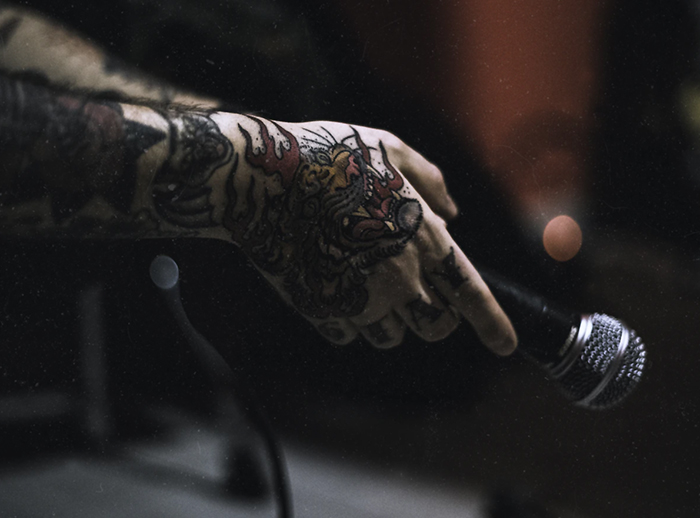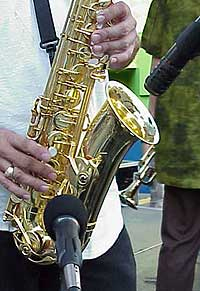
The first consideration is if the bass guitar has a pickup. Usually it does — the cost of a pickup is peanuts compared to the cost of the almost six-foot-tall handmade instrument.
What I like to do is use a DI on the pickup and capture the amp with an A-T ATM250, and than combine the two inputs. The DI provides the “high-end snap” of the strings and the mic gets the “low-end meat” of the instrument body.
If the bass doesn’t have a pickup, then consider aiming the mic just above the bridge, as close as possible without getting in the way of the musician. The bridge is the piece of carved wood that stands between the two f-holes on the body of the bass, and it suspends the strings. Pluck the string, it vibrates, and that vibration is sent to the body of the bass through the bridge.
Next, electric bass. Usually I get a good signal just with the DI. However, for more “bass driven” music, adding a microphone provides more to work with. I put the mic (again, ATM250) about a quarter-inch away from the grille, aimed at the speaker cone.
One input may sound good in the low end and the other may sound better in the top end. Use EQ to extract some of the weaker sounding frequencies in either input so that when you combine them, they will compliment one another.
Moving on to horns. The three most common ones are saxophone, trumpet, and trombone. I mic all three of them with an A-T ATM350A clipped on to the instrument bell, and this usually captures some cool sounds.
Sometimes I use two mics on saxophone — an SM57 about two inches from the bell, aimed down into the hole, and an A-T AE5400 placed three inches from the side of the bell, where the pad holes are. (Sound from a sax not only comes out of the big hole but out the side holes as well.) This technique “beefs up” the sax sound and is especially good for solos.
For trumpet and trombone, on occasion, I use the beautiful beyerdynamic M88 microphone, which really works well for both instruments. Place the mic on a straight stand in front of the player and let him/her find the sweet spot — usually five to seven inches from the bell and a little off-axis from the center of the hole.
Finally we come to vocals. I personally have two favorites, A-T AE5400 and Shure BETA 58A.
If there are multiple vocals on stage, I go with the Beta 58A for each vocalist because the mic’s pattern is tighter, which helps in terms of the monitor situation because it boosts gain before feedback. (This is especially useful on smaller stages.) I also find that the BETA 58A sounds clear and crisp without EQ and the tighter pattern forces singers to come in nice and close, just where we want them, about an inch or two from the mic.
For a single vocal, I go with the AE5400 because it sounds sweet — so good, in fact, that I use it in my studio as well. The one concern for live purposes is that it’s “wider, looser” pattern can hamper gain before feedback.
As always, keep in mind of the 3-To-1 Rule, which states that basically two microphones should always be at least three times the distance from each other as they are from their source in order to avoid phase cancellation (destructive wave interference caused when two or more microphone outputs are mixed together). For example, if a mic is placed three inches from a snare, then there should be no other mic within nine inches of that snare mic.
I also suggest listening carefully to microphones in pairs, which really helps in terms of sorting out phasing problems.
Happy miking!

